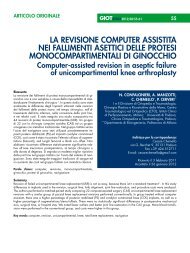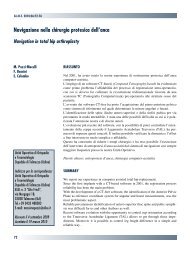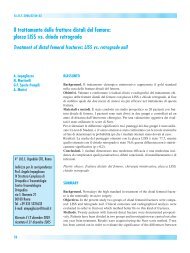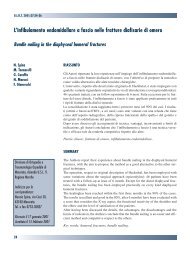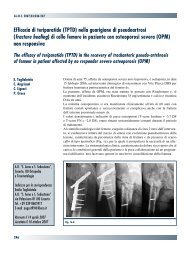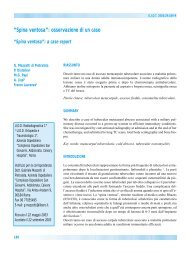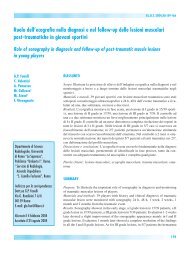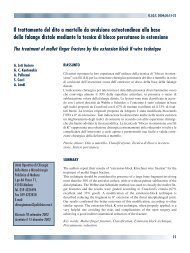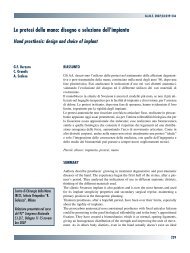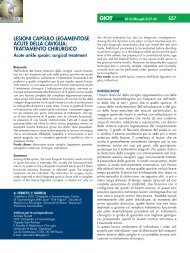Vol.XXXVII, Suppl. 1 - Giornale Italiano di Ortopedia e Traumatologia
Vol.XXXVII, Suppl. 1 - Giornale Italiano di Ortopedia e Traumatologia
Vol.XXXVII, Suppl. 1 - Giornale Italiano di Ortopedia e Traumatologia
You also want an ePaper? Increase the reach of your titles
YUMPU automatically turns print PDFs into web optimized ePapers that Google loves.
s104<br />
articolari. Lo spessore ideale è in<strong>di</strong>cato tra i 50 e i 100<br />
µm, probabilmente restringibile a 70÷80 µm.<br />
Substrato. Questo può essere il punto critico del rivestimento<br />
poiché l’adesione dell’HA sui metalli non è poi così<br />
solida.<br />
Come già citato, il rivestimento è suscettibile <strong>di</strong> riassorbimento<br />
da parte degli osteoclasti, e circa il 20% del rivestimento<br />
può essere rimosso entro i due anni dall’impianto,<br />
con rischio <strong>di</strong> mobilizzazione dello stesso.<br />
Di recente proposta una strategia alternativa che prevede<br />
<strong>di</strong> adottare un doppio rivestimento realizzando un coating<br />
<strong>di</strong> HA su un rivestimento poroso metallico (metal-coating).<br />
L’obiettivo è <strong>di</strong> sfruttare la capacità osteoinduttive dell’HA<br />
creando comunque un substrato che faciliti la crescita ossea<br />
producendo una secondary fi xation.<br />
Interessante il caso riportato da Rubman et al. 21 , dove<br />
due protesi dello stesso tipo (una rivestita con HA e una<br />
con rivestimento metallico poroso) impiantate dallo stesso<br />
chirurgo su una donna <strong>di</strong> 35 anni, sono state analizzate<br />
(post-mortem). Il metodo ABI (Appositional Bone Index)<br />
dava un 83 ± 12% per l’impianto con HA, mentre il secondo<br />
un 30 ± 11%. Un’ulteriore <strong>di</strong>fferenza tra i due rivestimenti<br />
è la <strong>di</strong>versa tipologia <strong>di</strong> tessuto che cresce a<br />
contatto: per il rivestimento in titanio poroso c’è crescita<br />
<strong>di</strong> tessuto fi broso, mentre sull’HA c’è un ancoraggio fi -<br />
broso più forte, vista la presenza <strong>di</strong> fi brocartilagine, una<br />
più alta concentrazione <strong>di</strong> collagene e un’orientazione<br />
ra<strong>di</strong>ale delle sue fi bre 22 . Un rivestimento in HA (semplice)<br />
mostra un aumento del “bone ingrowth” dell’8% rispetto<br />
al rivestimento in titanio poroso.<br />
Il vantaggio per il paziente può essere trovato in questo<br />
stu<strong>di</strong>o 23 : minor thigh pain con gli steli rivestiti in HA a 12<br />
settimane e 6 mesi <strong>di</strong> follow-up.<br />
Bibliografi a<br />
1 Fernandes PR, Folgado J, Jacobs C, et al. A<br />
contact model with ingrowth control for bone<br />
remodelling around cementless stems. J Biomech<br />
2002;35:167-76.<br />
2 Pitto RP, Hayward A, Walker C, et al. Femoral<br />
bone density changes after total hip<br />
arthroplasty with uncemented taper-design<br />
stem: a fi ve year follow-up study. Int Orthop<br />
2010;34:783-7.<br />
3 Engh CA, Bobyn JD, Glassman AH. Porouscoated<br />
hip replacement: the factor governing<br />
bone ingrowth, stress shiel<strong>di</strong>ng, and clincal<br />
results. J Bone Joint Surg Br 1987;69:45-55.<br />
4 Viceconti M, Muccini R, Bernakiewicz M,<br />
et al. Large-sli<strong>di</strong>ng contact elementsaccurately<br />
pre<strong>di</strong>ct levels of bone-implant micromotion<br />
relevant to osseointegration. J Biomech<br />
2000;33:1611-8.<br />
5 Charnley J. Low friction arthroplasty of the<br />
hip. Berlin: Springer-Verlag 1979.<br />
V. costa, s. can<strong>di</strong>otto<br />
6 Galante JO, Rostoker W, Lueck R, et al. Sintered<br />
Fiber Metal Composite as a Basis for<br />
attachment oh implants to bone. J Bone Joint<br />
Surg Am 1971;53:101-14.<br />
7 Galante JO, Rostoker W, Doye JM. Failed<br />
femoral stems in total hip prostheses. A<br />
report of six cases. J Bone Joint Surg Am<br />
1975;57:230-6.<br />
8 Fernandes PR, Folgado J, Ruben RB.<br />
Shape optimization of a cementless hip<br />
stem for a minimum of interface stress and<br />
<strong>di</strong>splacement computer methods in biomechanics<br />
and biome<strong>di</strong>cal engineering.<br />
Comput Methods Biomech Biomed Engin<br />
2004;7:51-61.<br />
9 Folgado J, Fernandes PR, Jacobs CR, et al.<br />
Infl uence of femoral stem geometry, material<br />
and extent of porous coating on bone<br />
ingrowth and atrophy in cementless total hip<br />
arthroplasty: an iterative fi nite element model.<br />
Comput Methods Biomech Biomed Engin<br />
200912;2:135-45.<br />
Uno stu<strong>di</strong>o sulla migrazione degli steli femorali rivestiti in<br />
poroTi e HA 24 : tutti sono migrati a 3 mesi; da 3 a 12 mesi<br />
la migrazione <strong>di</strong> quelli poroTi è continuata, mentre quella<br />
degli HA si è stabilizzata. A 12 mesi una migrazione<br />
totale molto inferiore per gli HA. La subsidence massima<br />
è comunque stata <strong>di</strong> 0,2 mm. L’HHS era uguale preoperatoriamente<br />
per i due gruppi, mentre al follow-up era<br />
migliore per il gruppo con rivestimento in HA.<br />
concLusionE<br />
La ricerca <strong>di</strong> una risposta defi nitiva che ci aiuti a meglio<br />
comprendere l’infl uenza dell’estensione del rivestimento<br />
sull’osteointegrazione non può <strong>di</strong>rsi raggiunta. Appare<br />
convinzione comune che rispetto alla sola superfi cie<br />
microporotica, quella con una ricopertura <strong>di</strong> materiale<br />
osteoinducente, soprattutto <strong>di</strong> idrossiapatite, abbia una<br />
maggiore osteointegrazione. Inoltre vi è convergenza <strong>di</strong><br />
opinione sul affermare che estendere il rivestimento a tutto<br />
lo stelo sia fondamentale per una stabile osteointegrazione<br />
secondaria, anche se ciò può innescare fenomeni <strong>di</strong><br />
stress shil<strong>di</strong>ng con dolore tipo thigh pain. Tuttavia alcuni<br />
riba<strong>di</strong>scono l’importanza <strong>di</strong> <strong>di</strong>versifi care l’estensione<br />
della ricopertura dello stelo con elementi osteoinducenti<br />
in relazione al design protesico. In particolare si ritiene<br />
corretto affermare che un rivestimento esteso è da preferirsi<br />
per steli a presa “<strong>di</strong>stale” o “metafi saria”(es: steli<br />
retti o rastremati), ed invece un rivestimento parziale è da<br />
adottare per steli a presa “prossimale” o “metaepifi saria”<br />
(es: steli anatomici). Tali affermazioni non rappresentano<br />
che delle semplifi cazioni che ci aiutano a chiarire ed a<br />
comprendere meglio alcuni aspetti della fi ssazione secondaria,<br />
lasciando tuttavia irrisolti molti dei quesiti che tale<br />
argomento ancora solleva.<br />
10 Wolff J. The law of bone remodelling. Berlin,<br />
Heidelberg: Springer-Verlag 1986.<br />
11 Engh CA, Bobyn JD. The infl uente of stem<br />
size and extent of porous coating on femoral<br />
bone resortpion after primary cementless<br />
hip arthroplasty. Clin Orthop Related Res<br />
1987;(231):7-28.<br />
12 McAuley JP, Culpepper WJ, Engh CA. Total<br />
hip arthroplasty: concerns with extensively<br />
porous coated femoral components. Clin Orthop<br />
Relat Res 1998;(355):182-8.<br />
13 Naumann T, Buchner F, Eckardt V. Pain in the<br />
thigh following Zweymuller’s total endoprosthesis:<br />
computerized tomography stu<strong>di</strong>es<br />
of the morphological behavior of the meta<strong>di</strong>aphyseal<br />
femur. Z Orthop Ihre Grenzgeb<br />
1987;125:664-8.<br />
14 Schramm M, Keck F, Hohmann D, et al. Total<br />
hip arthroplasty using an uncemented femoral<br />
component with taper design: outcome at<br />
10-year follow-up. Arch Orthop Trauma Surg<br />
2000;120:407-412.



